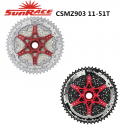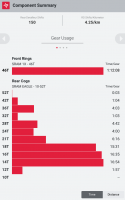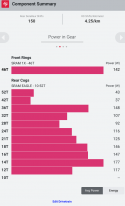I am just wondering if 9 teeth is 'too small' to turn, if there is such a thing. I changed my Q45 to AXS GX with 10/52 and 42t. Maybe I am not doing something right or not going fast enough, the 10t just feels kind of a drag and hard to turn. I usually would just stay there for a few seconds and shift lower. Just something to think about.
You are using an out of date browser. It may not display this or other websites correctly.
You should upgrade or use an alternative browser.
You should upgrade or use an alternative browser.
I never look back, darling. It distracts from the now, A V20c design journal
- Thread starter ratz
- Start date
I am just wondering if 9 teeth is 'too small' to turn, if there is such a thing. I changed my Q45 to AXS GX with 10/52 and 42t. Maybe I am not doing something right or not going fast enough, the 10t just feels kind of a drag and hard to turn. I usually would just stay there for a few seconds and shift lower. Just something to think about.
I wonder too at what point we hit the point of diminishing returns. FWIW, SRAM had this to say about 10t vs 11t.
Does the loss of efficiency (1%) hold for 9t?
ratz
Wielder of the Rubber Mallet
I consider that 9T a going downhill gear. Part of this experiment is to put it on the road and see how it feels. Cassette spacing is always a thing. You have to tweak if the gaps leave you at a crap cadence for a given speed. For me, I always need two things: (1) A low gear I can push on 10% grades that moves the bike fast enough not to fall over. (2) Gears need the middle of the cassette that I can ride in and have the right cadences for rollers. That's why cassette analysis and I'll have access to 44/46/48 T rings. Think being down near 44 is going to be the sweet spot; with the side benefity of making the front of the bike lighter
I like this comment for the forums at stack exchange
Considering the best of us are in the <= 240 Watt range, those are good percentages.
Anyhow designing by actually testing is still my thing so here we go, should be fun.
I like this comment for the forums at stack exchange
Almost each time 10T (or 9T) sprockets on cassettes are mentioned, there are remarks about efficiency losses when such sprockets are used. But I haven't found quantified information about these claims.
The only reference I found so far is this article from SRAM, where they actually do actually aknowledge that 10T sprockets are less efficient, but they mention that it's incorrect to only look at this aspects: modern drivetrains are designed as a whole and that they actually have other ways to limit these efficiency losses: chain design, larger jockey wheels, teeth shape and thickness, and chainring design all impact efficiency. Looking at the big picture, at 44kph on flat, for a rider producing 400W, drivetrain losses represent only 5% of the total losses (the rest being shared between aero 86% and rolling resitance 9%). Using a 10T sprocket is according to them 1% less efficient than a 11T on, but that would represent about 0.05% of the total, which I would qualify as negligible (but I'm not a pro racer)
Are there other studies (and probably less biaised) that study theses losses? Even if SRAM is wrong by a 20 factor, it would be still quite negligible for non-competitive uses.
Considering the best of us are in the <= 240 Watt range, those are good percentages.
Anyhow designing by actually testing is still my thing so here we go, should be fun.
Frito Bandito
Zen MBB Master
I use a 53/36t chainring and an Ultegra 12-speed 11/30t or an 11/34t cassette with SRAM AXS, and there are only a few conditions where I am actually hoping for another top gear. This is when there is a massive tailwind, or on a descent. My cadence at about 55-60kph is not too high then, but at 65-70kph it is 120. I sometimes think of going to a SRAM cassette that will give me access to a 10t for that extra gear, but last time I checked SRAM cassettes were way out of my budget. The only other option is a whole new crankset because my 105 R7000 cranks don't come in anything larger.
ratz
Wielder of the Rubber Mallet
Yeah prices on cassettes are way up. But you can get cool things like: https://us.3t.bike/en/products/drivetrain/cassette-579.html
If I was building a 2x11 I’d use one of those and 34/50 qring to make a climber. That would have rocked on the RAAM bikes
Sunrace still makes some affordable stuff : https://www.amazon.com/SunRace-CSMX9X-11-SPEED-XD-DRIVER-CASSETTE/dp/B07S39TCPT?th=1&psc=1
Pretty much thought for the fancy stuff you will have to swap the free hub to an XDR driver Then you can use both XD and XDR cassette. That’s usually at $60US-ish upgrade and frankly it’s better tech so there is that.
Anything low cost is gonna be aluminum and you just can’t make small cogs from Aluminum it will fall apart in 100miles
If I was building a 2x11 I’d use one of those and 34/50 qring to make a climber. That would have rocked on the RAAM bikes
Sunrace still makes some affordable stuff : https://www.amazon.com/SunRace-CSMX9X-11-SPEED-XD-DRIVER-CASSETTE/dp/B07S39TCPT?th=1&psc=1
Pretty much thought for the fancy stuff you will have to swap the free hub to an XDR driver Then you can use both XD and XDR cassette. That’s usually at $60US-ish upgrade and frankly it’s better tech so there is that.
Anything low cost is gonna be aluminum and you just can’t make small cogs from Aluminum it will fall apart in 100miles
Frito Bandito
Zen MBB Master
$60 isn't too bad for a SRAM driver IMO. I just don't know if the hub on my 2013 Mavic CXR rims could be changed. I could probably lace the drive wheel to Chris King or Industry 9 hub with a SRAM driver in a "worst case" scenario but I should put that out of my head because my wallet can't handle that either lol.
ak-tux
Zen MBB Master
I think you have a point there. Especially with an "angled" chainline typical of a 1X drivetrain.I am just wondering if 9 teeth is 'too small' to turn, if there is such a thing. I changed my Q45 to AXS GX with 10/52 and 42t. Maybe I am not doing something right or not going fast enough, the 10t just feels kind of a drag and hard to turn. I usually would just stay there for a few seconds and shift lower. Just something to think about.
The 10 tooth sprocket is only usefull when you are descending in excess of 60Kph and allows you to continue pedalling. 9 teeth seem a little extreme to me but I guess that SRAM and Campy have done their R&D and think it's useable.
Unless you are a tour de france rider, I guess 48x10 is more than sufficient for most of us mere mortals!
For a 1x system I'd go for a 48T or a 46T combined with a and a 10-50 Cassette .
For the budget cyclist I'd go for a HG feehub with an 11-51 Cassette like Sunrace CSM903. If combined with a 50T or a 48T or even a 46T chainring and it would still be almost as good as the expensive SRAM stuff. One just needs to practice and work on a good cadence range.
Sunrace CSM903
.12-Speed Wide Ratio
.A7075 39-45T-51T Sprocket
.Alloy Spiders
.Alloy Lockring & Spacers
.O (Black Chrome)
.X (Metallic Silver)
.1 (Metallic Silver + Black Ano.)
.Weight - 497g
- gear ratio: 11-13-15-17-19-21-24-28-33-39-45-51

Last edited:
Frito Bandito
Zen MBB Master
Heading to bed now, but a quick search turned up these pages that might help...It seems I’m usually in the middle, but I’d like to know the data. Since my Garmin can display the current gear (SRAM AXS) and report a shift count, I should be able to see details. How much time is spent in any given gear? Does anyone know how to get that info?
SRAM | AXS

Mathew Fy
GRU
That was easy. Thank you.Heading to bed now, but a quick search turned up these pages that might help...
SRAM | AXS
axs.sram.com

A flat ride:


A hilly ride:


It almost looks like I favor the odd gears.
ratz
Wielder of the Rubber Mallet
Love that Data
Here's the noodling going on in the build lab. How small can we get the front ring to get the weight down on the nose? While ensuring we we cab be in a good cog size when cruising? Cruising I define as 75-90 RPM and traveling 19-24mph.
I want to be in a 17T-13T range for efficiency and drive-train wear at that speed. Which combo give that and have the mountain goat bail out gear at < 25 gear inches
The next one is to watch the gap; when tired, you all know we pedal 75 rpm, when we are relaxing, we do 80 rpm, and when we focus 90+ what is the speed gap when those are true from cog to cog?
Turns into an eye chart, but I went with the 9x50 to bias my self 1 cog to the left on the stack for the 15 and the 13, and I'm going to test a rotor off-set axle I want to see how straight I can get the chain line....

Here's the noodling going on in the build lab. How small can we get the front ring to get the weight down on the nose? While ensuring we we cab be in a good cog size when cruising? Cruising I define as 75-90 RPM and traveling 19-24mph.
I want to be in a 17T-13T range for efficiency and drive-train wear at that speed. Which combo give that and have the mountain goat bail out gear at < 25 gear inches
The next one is to watch the gap; when tired, you all know we pedal 75 rpm, when we are relaxing, we do 80 rpm, and when we focus 90+ what is the speed gap when those are true from cog to cog?
Turns into an eye chart, but I went with the 9x50 to bias my self 1 cog to the left on the stack for the 15 and the 13, and I'm going to test a rotor off-set axle I want to see how straight I can get the chain line....

ratz
Wielder of the Rubber Mallet
Ok, so this post is mostly about two technological changes to my usual repertoire and a new one.
Historically I have used Molten Speed-wax and Orange Endurance sealant. Speed-wax was such an easy win, but darn if Tubeless sealant was a long and messy journey. 4 Generations of wheels later, and tubeless might just be mundane now.
First, the wax. Molten has been good to me over the years, but it was always slow to melt and slow to dry. During the time I was off the bike, Silca brought a wax to market; two waxes, in fact. I was always a fan of Silca.cc does and thought I'd try it.
Secret Chain Wax Blend: https://silca.cc/collections/chain-lube-wax/products/secret-chain-wax-blend. $40
Results on four bikes have been great; the wax melts fast, dries fast, and the chain is more bike ready when it goes on. The chain is still deadly silent after 35 hours on the trainer, so I'm sold on it. Molten finally has come down in price over the years and is about the same price now, but I'm going with the new stuff this season.
I was looking for something other than a new wax. That actually was a side effect of dreading doing sealant in the tires. Right now in Texas, it's about 115 during the day in the sun and 102 in the Garage, which means the sealant will need regular replacement and periodic cleaning. That had been lamenting that no one had figured out a Sealant booster to prevent that. So I googled, and darn it if Josh at Silca didn't feel the same way.
Sealant
 Replenisher
Replenisher

So I had to try it.
After prepping the tires, I did the unthinkable by injecting the sealant with the valve core installed—blasphemy, utter Blasphemy; no clogs, not a one. So obviously, the tires would mount awful. Nope, simple and clean; they popped right on the rims. After a week, they are holding air better than any of the other sealants I have used; Stans, Bontrager, Orange, and Orange Endurance. Can't wait to try the replenisher.
So what's the third item? Well, that's all new tech for roadies at least.
With all the testing of the Tubeless tires over the last few years, we have been on the leading edge of road tubeless, and that's meant some bumps and bruises. The worst ever was the first tubeless I tested—some Bontrager aluminum carbon hybrids. I've ridden front flats on the V and S Series bikes without a problem; unless the tire comes off the rim; when that happens, I've gone for somebody surfing on asphalt and that always means three weeks off the bike, and some get back on the horse trauma if that occurred at 28mph. I believe I've done the slide-out four times, it's always a ride-home event (leverage shot before it wears off), but the road rash is unavoidable and wastes riding time. So we need a run-flat solution for our front tires for safety. I was hoping that would be just better fitting tires and sealant; watching Paris Roubaix told me we aren't there yet.
So we are going to steal from the Mountain bike space and run inserts, but these are different from your parent's inserts these are pretty cool.
Road tubeless inserts:
The general concept is that when the tire is inflated to normal pressure, this foam insert compresses against the RIM and becomes a non-factor to the ride. When you lose pressure completely, the insert expands to fill the tire void, so it holds its shape so the tire stays mounted. The result is the same as a 20psi tire that can be ridden. We all know that a V/S Series is going to be front-end squirrelly on 20 psi tire, but It will be a lot easier to ride it to a safe stop while the pressure is dropping slowly.
Going to be a mainstay of my front tires for the next while.
Historically I have used Molten Speed-wax and Orange Endurance sealant. Speed-wax was such an easy win, but darn if Tubeless sealant was a long and messy journey. 4 Generations of wheels later, and tubeless might just be mundane now.
First, the wax. Molten has been good to me over the years, but it was always slow to melt and slow to dry. During the time I was off the bike, Silca brought a wax to market; two waxes, in fact. I was always a fan of Silca.cc does and thought I'd try it.
Secret Chain Wax Blend: https://silca.cc/collections/chain-lube-wax/products/secret-chain-wax-blend. $40
Results on four bikes have been great; the wax melts fast, dries fast, and the chain is more bike ready when it goes on. The chain is still deadly silent after 35 hours on the trainer, so I'm sold on it. Molten finally has come down in price over the years and is about the same price now, but I'm going with the new stuff this season.
I was looking for something other than a new wax. That actually was a side effect of dreading doing sealant in the tires. Right now in Texas, it's about 115 during the day in the sun and 102 in the Garage, which means the sealant will need regular replacement and periodic cleaning. That had been lamenting that no one had figured out a Sealant booster to prevent that. So I googled, and darn it if Josh at Silca didn't feel the same way.
Sealant

Ultimate Tubeless Sealant w/FIBERFOAM
When sealing the largest punctures is important, you can't look further than SILCA Ultimate Tubeless Sealant w/Fiberfoam. Sealing up to 8mm punctures and lasting up to three months is the perfect match for your race season.
silca.cc

Ultimate Tubeless Sealant Replenisher
Installation Instructions Foaming natural latex formula, environmentally safe, contains no ammonia. Use to replenish SILCA Ultimate Sealant with Carbon Foam every 90-120 days. Use of the replenisher may extend sealant life up to 1 year! Replenisher can be used on its own down to 0F/-18C. It is...
silca.cc
So I had to try it.
After prepping the tires, I did the unthinkable by injecting the sealant with the valve core installed—blasphemy, utter Blasphemy; no clogs, not a one. So obviously, the tires would mount awful. Nope, simple and clean; they popped right on the rims. After a week, they are holding air better than any of the other sealants I have used; Stans, Bontrager, Orange, and Orange Endurance. Can't wait to try the replenisher.
So what's the third item? Well, that's all new tech for roadies at least.
With all the testing of the Tubeless tires over the last few years, we have been on the leading edge of road tubeless, and that's meant some bumps and bruises. The worst ever was the first tubeless I tested—some Bontrager aluminum carbon hybrids. I've ridden front flats on the V and S Series bikes without a problem; unless the tire comes off the rim; when that happens, I've gone for somebody surfing on asphalt and that always means three weeks off the bike, and some get back on the horse trauma if that occurred at 28mph. I believe I've done the slide-out four times, it's always a ride-home event (leverage shot before it wears off), but the road rash is unavoidable and wastes riding time. So we need a run-flat solution for our front tires for safety. I was hoping that would be just better fitting tires and sealant; watching Paris Roubaix told me we aren't there yet.
So we are going to steal from the Mountain bike space and run inserts, but these are different from your parent's inserts these are pretty cool.
Road tubeless inserts:
The general concept is that when the tire is inflated to normal pressure, this foam insert compresses against the RIM and becomes a non-factor to the ride. When you lose pressure completely, the insert expands to fill the tire void, so it holds its shape so the tire stays mounted. The result is the same as a 20psi tire that can be ridden. We all know that a V/S Series is going to be front-end squirrelly on 20 psi tire, but It will be a lot easier to ride it to a safe stop while the pressure is dropping slowly.
Going to be a mainstay of my front tires for the next while.
Frito Bandito
Zen MBB Master
Ratz, like you, I spend a lot of time searching for new products that actually work, and those inserts look to be the bees knees. A sudden lost of front tire pressure is a horror movie for bikers, but not crashing is still possible provided the rider keeps his wits and balance. In a turn it is almost a certainty that a crash is going to occur. A front time coming off even when traveling in a straight line is as you know virtually a certainy. But when I saw the inserts you listed I feel that at least riders have a fighting chance in a turn with a sudden loss of pressure. Will those help keep the tire on? Probably so in many situations, so they look like something we should consider.
I bought GP 5000 TL tires but haven't put them on my new wheels yet because I couldn't get the 28mm on in my first attempt. I got a Schwalbe One TLE on, but in the morning most of the air was gone so I bought some new rim tape. For now, I am running tubed GP 5000 tires, but I might give the inserts a try once my current tires need replacing.
I bought GP 5000 TL tires but haven't put them on my new wheels yet because I couldn't get the 28mm on in my first attempt. I got a Schwalbe One TLE on, but in the morning most of the air was gone so I bought some new rim tape. For now, I am running tubed GP 5000 tires, but I might give the inserts a try once my current tires need replacing.
Mathew Fy
GRU
My own experience with this sealant wasn’t good. After a few months of regular use the wheel was way out of balance. Removal revealed not the usual bath tub ring of congealed latex but large mass in one area with some large boogers floating around. I don’t know if the carbon fibers precipitated this or what but I’m back to the Orange. YMMVSilca
ratz
Wielder of the Rubber Mallet
Thanks for the Data Point.My own experience with this sealant wasn’t good. After a few months of regular use the wheel was way out of balance. Removal revealed not the usual bath tub ring of congealed latex but large mass in one area with some large boogers floating around. I don’t know if the carbon fibers precipitated this or what but I’m back to the Orange. YMMV
Some questions that will help my journey:
Did you use the replenisher monthly as suggested, or were you just topping off the fluid every 30 days with .5 ounces?
How many ounces were you running in the wheels to start with?
Are you storing the bikes indoors or in a hot/cold garage?
This will be the first time in history I'm not just wingin it because of the heat down here, I'm actually making a log book this time
Mathew Fy
GRU
The bike is kept in a basement at around 60-65* F, 50-60% humidity. I had filled the tire with the maximum amount of sealant. This stuff can’t be injected through a valve stem, must be poured into a pocket of tire before reseating it. I used their Replenisher twice, about 20 ml after about 8 weeks each. Tire is Corsa Control. Ridden at least once / week until better weather, then more often.Thanks for the Data Point.
Some questions that will help my journey:
Did you use the replenisher monthly as suggested, or were you just topping off the fluid every 30 days with .5 ounces?
How many ounces were you running in the wheels to start with?
Are you storing the bikes indoors or in a hot/cold garage?
This will be the first time in history I'm not just wingin it because of the heat down here, I'm actually making a log book this time
ratz
Wielder of the Rubber Mallet
Interesting I did multiple wheels through the stem without removing the value. I wonder what’s different? stuff I have is like water. Bunch more wheels to do I’m about to learn. If it goes pear shaped I’ll be less surprised. thanks MathewThe bike is kept in a basement at around 60-65* F, 50-60% humidity. I had filled the tire with the maximum amount of sealant. This stuff can’t be injected through a valve stem, must be poured into a pocket of tire before reseating it. I used their Replenisher twice, about 20 ml after about 8 weeks each. Tire is Corsa Control. Ridden at least once / week until better weather, then more often.
Mathew Fy
GRU
Like you, injected sealant with a syringe and tube. Then I noticed the carbon fibers settle, it wasn’t until I agitated the sealant that I discovered I couldn’t inject the stuff. Josh was right when he said it had to be poured in.Interesting I did multiple wheels trough the stem without removing the value. I wonder what’s different? stuff I have is like water


